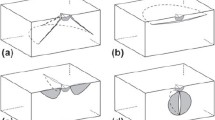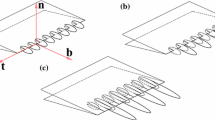Abstract
A theory is outlined for determining the initiation of fracture and initial fracture propagation in elastic brittle materials having non-linear Mohr fracture envelopes. This theory is applied to a specific boundary value problem, i.e. a truncated quarter plane with arbitrary traction distribution on the truncated boundary and varying confining pressure. This problem simulates the chipping phase of the penetration of a wedge shaped tool into an elastic brittle material. Numerical results are obtained for two rock materials, Blair dolomite and quartzite.
Results indicate that for increasing confining pressure, a limit condition is reached for both fracture initiation location and force. This limit location is closer to the boundary than the fracture initiation points at lower confining pressures, indicating smaller chips. It is also found that initial fracture propagation is less clearly defined at higher confining pressures. Both of these results have been observed experimentally.
Résumé
On met en évidence une théorie pour la détermination de l'amorçage d'une rupture et du début de la propagation d'une rupture dans des matériaux fragiles élastiques caractérisés par une courbe enveloppe de rupture de Mohr non linéaire. Cette théorie est appliquée à un problème de valeur aux limites, à savoir un quart de plan tronqué soumis, à la périphérie de la troncature, à une distribution arbitraire de charges de traction et de pressions de maintien. Ce problème évoque la phase de formation d'un copeau lors de la pénétration d'un outil en forme de coin dans un matériau fragile élastique. Des résultats numériques sont obtenus dans le cas de deux roches: une dolomite de Blair et une quartzite.
Ces résultats indiquent que, lorsque la pression de maintien s'accroît,on atteint une condition limite à la fois pour la localisation et la tension d'amorçage de la rupture, Cette localisation est plus voisine du bord libre que le point d'amorçage correspondant à des pressions de maintien plus basses, ce qui se traduirait par des copeaux plus petits. On trouve également que le début de propagation de la rupture est plus difficile à définir clairement lorsque les pressions de maintien sont plus élevées. Ces deux types de résultats ont été confirmés expérimentalement.
Zusammenfassung
Man erläutert eine Theorie zur Bestimmung der Brucheinleitung und der Anfangsbruchausdehnung in elastisch spröden Materien mit unlinearen Mohrschenbruchhüllkurven. Diese Theorie wird auf ein spezifisches Grenzwert-problem angewandt, z.B. eine abgeschnittene Viertelebene mit einer willkürlichen Zugkraftverteilung an der abgeschnittenen Grenze und mit veränderlichem Einschließungsdruck. Dieses Problem simuliert die Aufbrechphase des Eindringens eines keilförmigen Instrumentes in ein elastisch sprödes Material. Numerische Ergebnisse werden für zwei Felsmaterien, Dolomit und Quarzit gegeben.
Die Ergebnisse zeigen daß für anwachsender Einschließungsdruck eine Grenzbedingung sowohl für den Brucheinleitungsort, als für die Kraft gegeben wird. Diese Grenzpunkte sind näher zur Grenze als die Brucheinleitungspunkte unter niedrigem Einschließungsdruck, die kleinere Splitter erzeugen. Es ergibt sich auch daß die Anfangsrißausdehnung sich weniger klar bei höherem Einschließungsdruck anzeigt. Beide Ergebnisse haben sich durch Versuche bestätigt.
Similar content being viewed by others
References
D.L., Sikarskie and N.J., Altiero, The Formation of Chips in the Penetration of Elastic-Brittle Materials (Rock), Journal of Applied Mechanics, 40, 3; Trans. ASME, 95, Series E, (1973) 791–798.
R., Benjumea and D.L., Sikarskie, On the Solution of Plane, Orthotropic Elasticity Problems by an Integral Method, Journal of Applied Mechanics, 39, Trans ASME, 94, Series E, (1972) 801–808.
B., Paul, Macroscopic Criteria for Flow and Fracture, Fracture: An Advanced Treatise, Vol. II, ed., Liebowitz, H., Academic Press, New York and London (1968) Chapter 4.
Z.T., Bieniawski, Mechanism of Brittle Fracture of Rock, International Journal of Rock Mech. Min. Sci., 4, (1967) 395–430.
W.F., Brace, Brittle Fracture of Rocks, State of Stress in the Earth's Crust, ed. W., Judd, Elsevier, New York (1964).
W.F., Brace, E., Silver, K., Hadley and C., Goetze, Cracks and Pores: A Closer Look, Sciencer, 178 (1972) 162–164.
B., Carnahan, H. A., Luther and J. O., Wilkes, Applied Numerical Methods, John Wiley and Sons, Inc., New York (1969) 574–584.
E.C., Robertson, Experimental Study of the Strength of Rocks, Bulletin of the Geological Society of America, 66 (1955) 1275–1314.
P.F., Gnirk and J.B., Cheatham, An Experimental Study of Single Bit-Tooth Penetration into Dry Rock at Confining Pressures of 0 to 5000 psi, Society of Petroleum Engineers Journal. AIME Trans., 234 (1965) 117–130.
N. J. Altiero and D. L. Sikarskie, Fracture Initiation in Elastic-Brittle Materials Having Nonlinear Fracture Envelopes, ORA Report No. 011909-1-T, The University of Michigan, (1974).
Author information
Authors and Affiliations
Rights and permissions
About this article
Cite this article
Altiero, N.J., Sikarskie, D.L. Fracture initiation in elastic brittle materials having non-linear fracture envelopes. Int J Fract 11, 431–440 (1975). https://doi.org/10.1007/BF00033529
Received:
Revised:
Issue Date:
DOI: https://doi.org/10.1007/BF00033529




